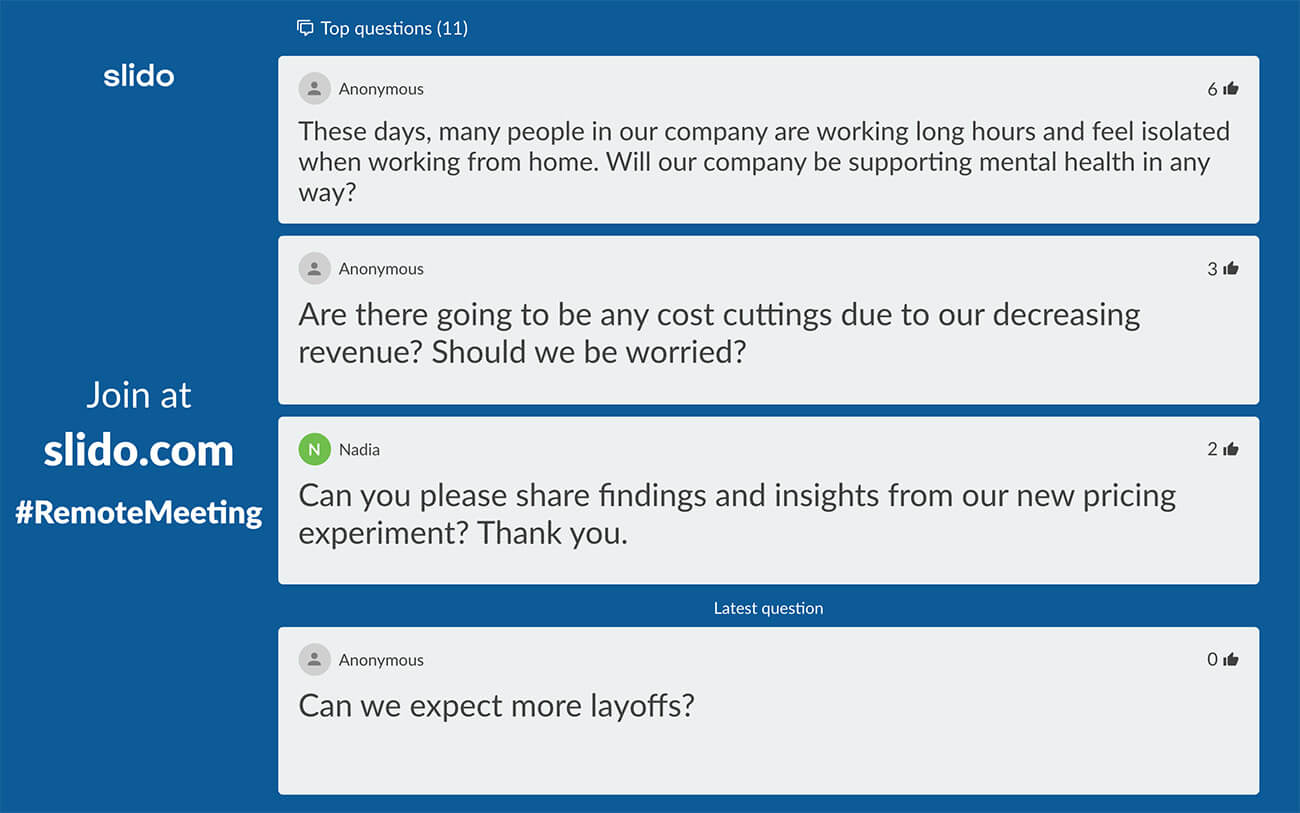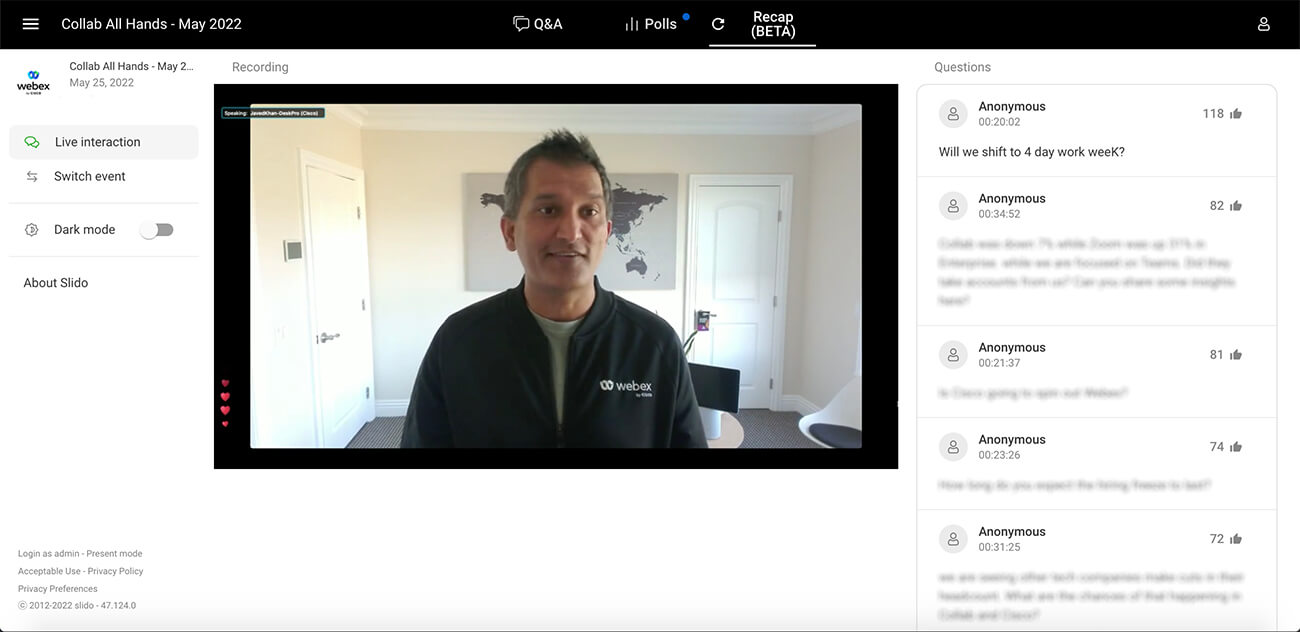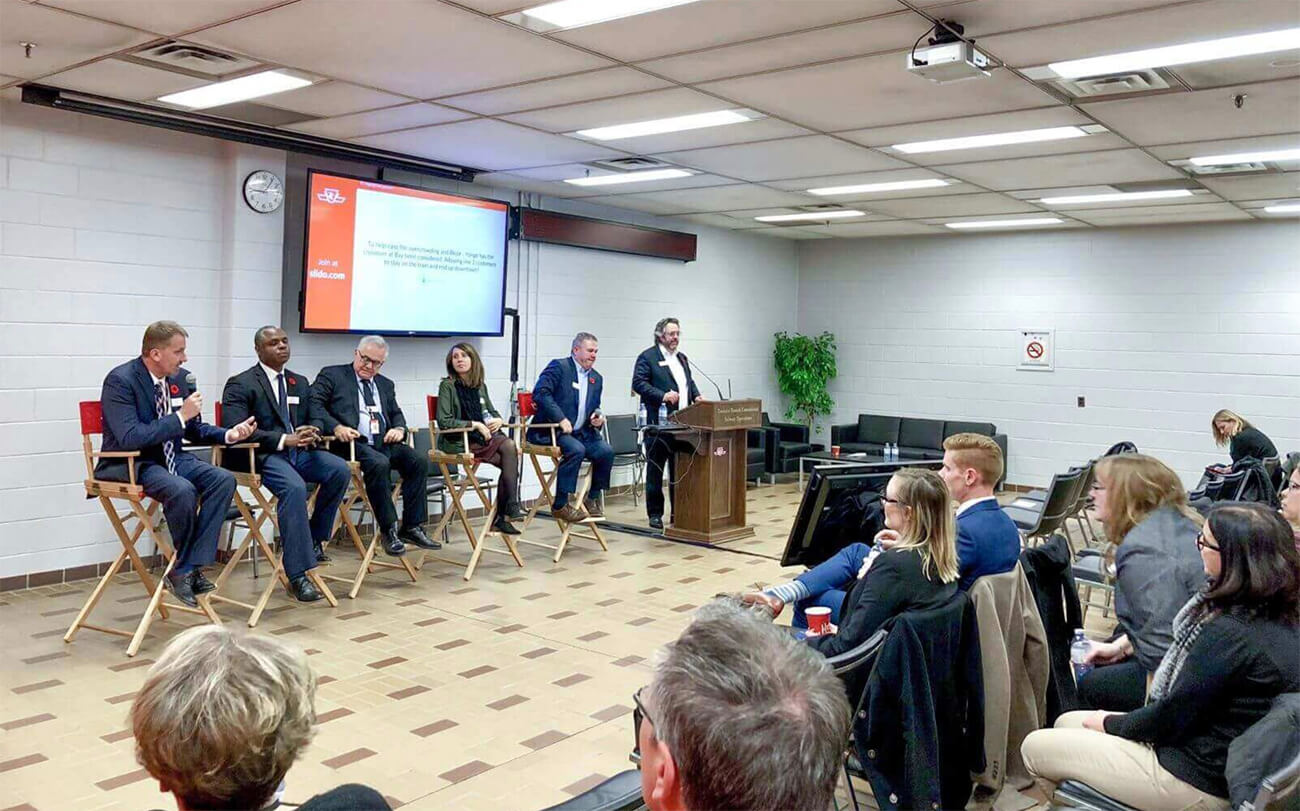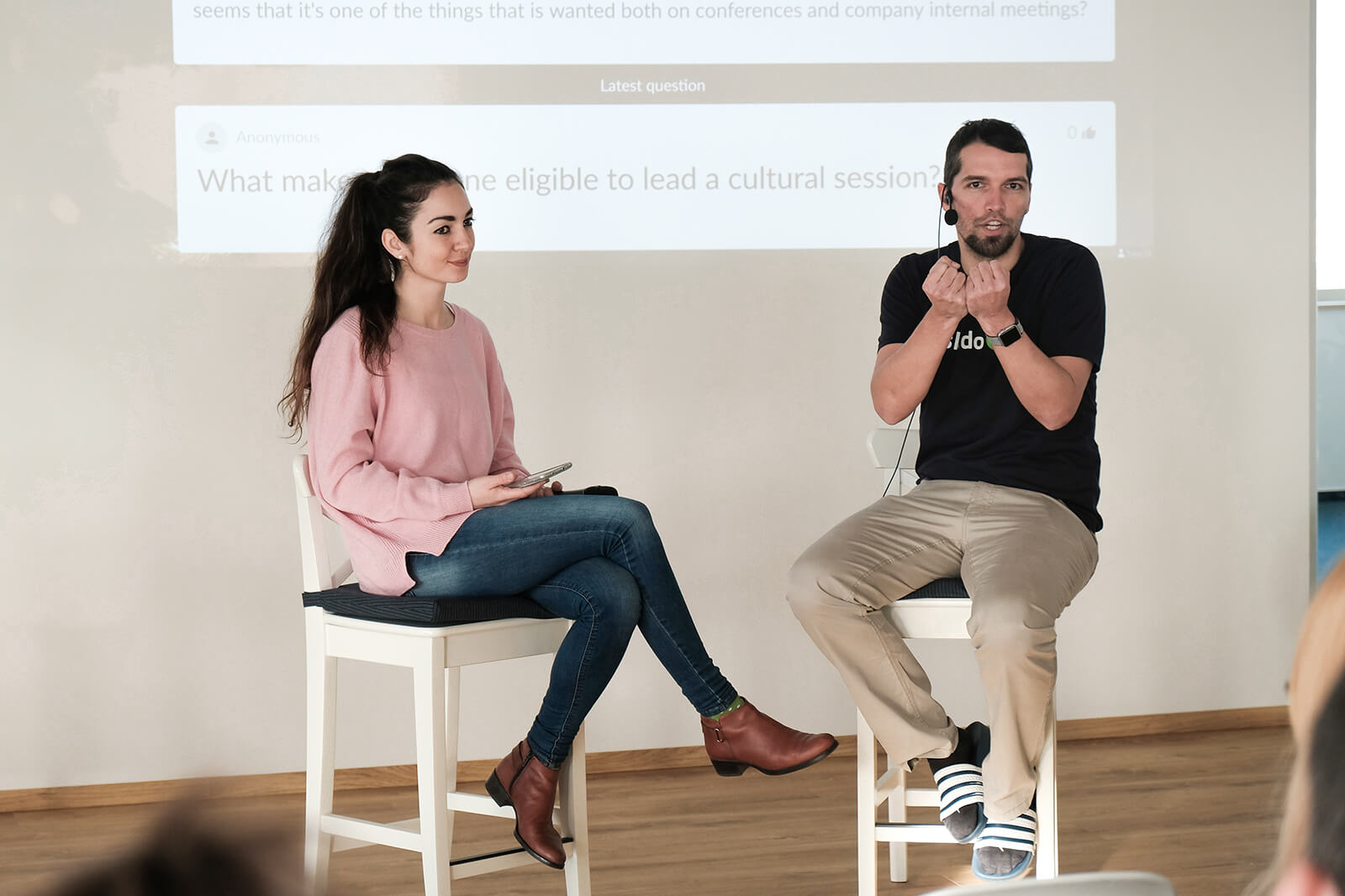When you’re running a Q&A session, a big advantage of using technology to collect questions is that participants will feel safe and less shy about speaking up and asking things.
Whether you’re running an all-hands, town hall, or a team meeting – it’ll be easier (and more practical) to ask through an app than to speak up and ask a question out loud.
But if you have to attach your name to your question, you might have as well have asked aloud, right?
The real power of a Q&A technology is in anonymity
Being able to stay anonymous gives employees the freedom to ask questions openly, without the fear of repercussions, embarrassment, or ridicule.
Actually, according to recent research, 74% of employees would be more inclined to give feedback about their company, workload, and culture if they were to give it anonymously.
An anonymous Q&A is more inclusive and transparent. It builds a more honest relationship between employees and leadership. It helps leaders find out what’s really on their employees’ minds.
But it’s also a double-edged sword.
Many of our clients wonder whether to risk receiving difficult, negative, or even toxic questions. Many leaders fear getting impromptu questions and being faced with addressing them live during a meeting.
In this article, we share the reasons why we think anonymous Q&A is a great tool for building healthy company culture but also the drawbacks and possible challenges.
Every company is different, and hence we encourage you to form your own opinion.
#1: Inclusion: Giving employees a safe space to ask questions
Giving the team a safe space to ask questions is essential for building trust and having an open culture. These are not only the words of Slido’s co-founder Peter Komornik but the Slido philosophy as well.
Having a Q&A session as part of your all-hands meeting agenda is the first sign that your company wants to give employees a voice. If they were to ask with their names, though, many people would be discouraged from asking in the first place.
Whether it’s because they’re shy or reluctant to be exposed for any reason, by giving people the option to ask anonymously, you’re empowering them to “speak up”.

Sure, this may sound scary for some, but as Kate Schroeder from Vimeo told us:
“It’s very important for employees to feel that they can ask questions and feel safe in asking those questions no matter what those questions are.”
At Suntory, they allow anonymous questions at their town hall meetings. According to their Corporate Strategy Planner, Norito Yonezawa, they help them get more interesting questions and uncover ideas even from silent employees.
As Norito adds, “it allows people to come out of their shells and overcome their shyness”.
Cisco follows this philosophy as well. Javed Khan, SVP and GM of Cisco Collaboration, spent almost 30 minutes at a recent all-hands meeting answering people’s anonymous questions in Slido.

It’s a way for the leaders to hear from and engage everybody equally – regardless of how shy or introverted they are, and regardless of their seniority, role, or gender.
#2: Employee engagement: An open Q&A is a way to engage everyone in a conversation
A Q&A session is a chance for leaders to engage their team members in a conversation and make themselves accessible to their employees.
Gallup research shows that having access to managers and building relationships with them is one of the main drivers of employee engagement.
A regular Q&A serves as a bridge between employees and leadership.
It provides a forum for employees to ask questions and get answers from their managers. It’s a good way to show that the leadership team cares about their employees’ concerns.
Besides Slido and Cisco, many big companies adopted this approach. Microsoft and Slack, for instance, run a monthly special Town Hall with Q&A where they meet up with their employees and open a forum for anonymous questions.
IBM and Facebook have adopted weekly AMA sessions to address their employees’ questions.
If employees are allowed to ask anonymously, it will encourage people to ask.
Not only will you get more questions, but they will also be more honest, which makes the Q&A more dynamic and worthwhile.
As Jessica Kosmack from TTC told us: “The anonymity provides a real level of honesty. We definitely received more questions because it was easy and you didn’t have to attach your name to it.”

#3: Transparency: Creating a more transparent culture, one Q&A at a time
Transparent communication in an organization is paramount when trying to build better employee experiences and boost engagement. Especially during times of change or crisis.
According to the 2021 Global Culture Report, organizations that increased transparency with employees during the Covid crisis saw, on average, an 85% increase in employee engagement and a 241% increase in employee Net Promoter Score.
Q&A or Ask Me Anything sessions help leaders actively engage with their staff and foster a more transparent culture. As our co-founder, Peter said:
“As leaders, we might not have every answer. But it’s extremely important to talk about the situation openly with our employees and make them feel included in the conversation. I believe we have a duty to hear our team out and reassure them that we’re in it together.”

A Berlin start-up Humanoo believes an anonymous Q&A to be critical for building a culture of transparency. As the company’s CEO, Maximilien Notter says:
“I decided to take a leap of faith. In our weekly all-hands call, I added an anonymous Q&A session via Slido. If you fail to address some of the questions before they become critical, they become rumors. And rumors do not let you have the chance to get ahead of them and explain what needs to be explained.”
Read also: Leadership AMA as a Bridge to More Transparency
#4: Leadership: Get ahead of potential issues by addressing them directly
During an all-hands meeting, Javed Khan, SVP and GM of Cisco Collaboration, commented: “I love Slido, there’s no hiding from the difficult questions.”
It’s a powerful statement. Not to hide from the tough questions is, after all, a brave move from any leader.
Humanoo’s Maximilien Notter, couldn’t have said it better: “There’s no more powerful example in my view than a leader who walks the talk, who puts himself at risk, by standing vulnerable in front of people, getting ready to answer the toughest questions.”
In truth, any problems or issues that people might have won’t disappear just because you don’t allow them to come to the surface during an anonymous Q&A session.
If anything, hiding from them would make them fester and grow. People will still be talking about them in the kitchen or in the hallways. With an anonymous Q&A, you have the chance to unearth them, answer them, and explain.
Peter Komornik says: “It’s tempting for leaders to just put their heads down… But if leaders don’t step up, people will go looking for the answers elsewhere resulting in fear and uncertainty.”

Knowing what bothers people then allows leaders to face the issues head-on and take action. The leadership and People teams will then be able to work together on solving the problems, leading to innovative solutions and better company culture.
It certainly was so for TTC. As their communications manager, Jessica told us: “The collected questions revealed unexpected knowledge gaps within the leadership. It was an eye-opener.”
Read also: How to Host Better Q&A Sessions at All-Hands Meetings
What are the potential challenges of anonymous Q&A?
To be frank, hosting an anonymous employee Q&A isn’t for everyone. Company cultures differ as much as company leaders and company values do.
Some of our clients do not allow anonymous questions because anonymous members tend to post negative or irrelevant comments or misuse the anonymous Q&A to criticize.
Some just have a different take on transparency and honesty. Here are a few comments from our clients.
- “If employees expect honesty from leadership then they need to start by being honest themselves.”
- “We can’t have a culture of radical candor if we allow anonymous questions.”
- “Not allowing anonymous questions makes people pose their questions in a better way. As a result, these people will also receive a better answer since, with harsh questions, leaders tend to be a little defensive, less constructive.”
From our discussions with clients, we have identified one main risk that comes with anonymous Q&A.
Challenge: Questions may be negative, irrelevant, or badly formulated
Anonymity gives people the freedom to post practically any question or comment.
In some cases, a person may ask a question that they wouldn’t dare to ask to a leader’s face. In some company cultures, employees might misuse or abuse anonymity to criticize or spread hatred.
Also, if their name isn’t attached to the question, some people tend to care less about the quality of their submission. As a result, you might get questions that are irrelevant, badly phrased, or written with bad grammar.
As Emily Scammell, Director of Internal Communications at Onfido, told us: “We have found that if people put their names, the questions tend to be a bit more intelligent and well thought-through.”
💪 How to handle it
You can prevent this by moderating questions. Moderation allows you to review the questions submitted by the participants before they appear live for everyone to see.
At Vimeo, they use moderation during their all-hands: “I push through all the questions unless it’s oppressive or pointed at a team or a team member or feels like it’s unproductive for everyone. In that case, I’ll respond and say please ask this differently or I don’t think we’re gonna answer this today.”
You can also benefit from Slido’s profanity filter that filters out all submissions which include inappropriate words (currently supporting only English) or enabling downvotes so that other team members can push such negative questions down by clicking a thumbs-down button.
Read also: 5 Ways to Deal With Difficult Employee Questions During Q&A
Also, setting clear guidelines and expectations can drastically improve the quality of your employees’ questions.
Nokia’s Communication specialists told us that their employees are instructed on how to use Slido before a Q&A: “Only respectful language is allowed and only questions that are related to the topics covered.”
“We accompanied Slido with the right messages and guidelines at every step of the process. As a result, we now get the quality of questions that we want,” shared another of our clients here.
Final thoughts & words of encouragement
As a final thought, we’d love to encourage and support you. Yes, it takes courage to be open to employees’ questions, especially anonymous ones. Above all, it takes buy-in from your company’s leaders.
But, if you want to build a healthy company culture, not shying away from employees’ questions is an important step towards it.
An open Q&A builds trust and helps you create a more transparent and open work environment. You’ll be able to clear up misunderstandings and get insights into sentiments and emotions that may be bubbling beneath the surface.
But all of that is worth the effort. Good luck. 💚




